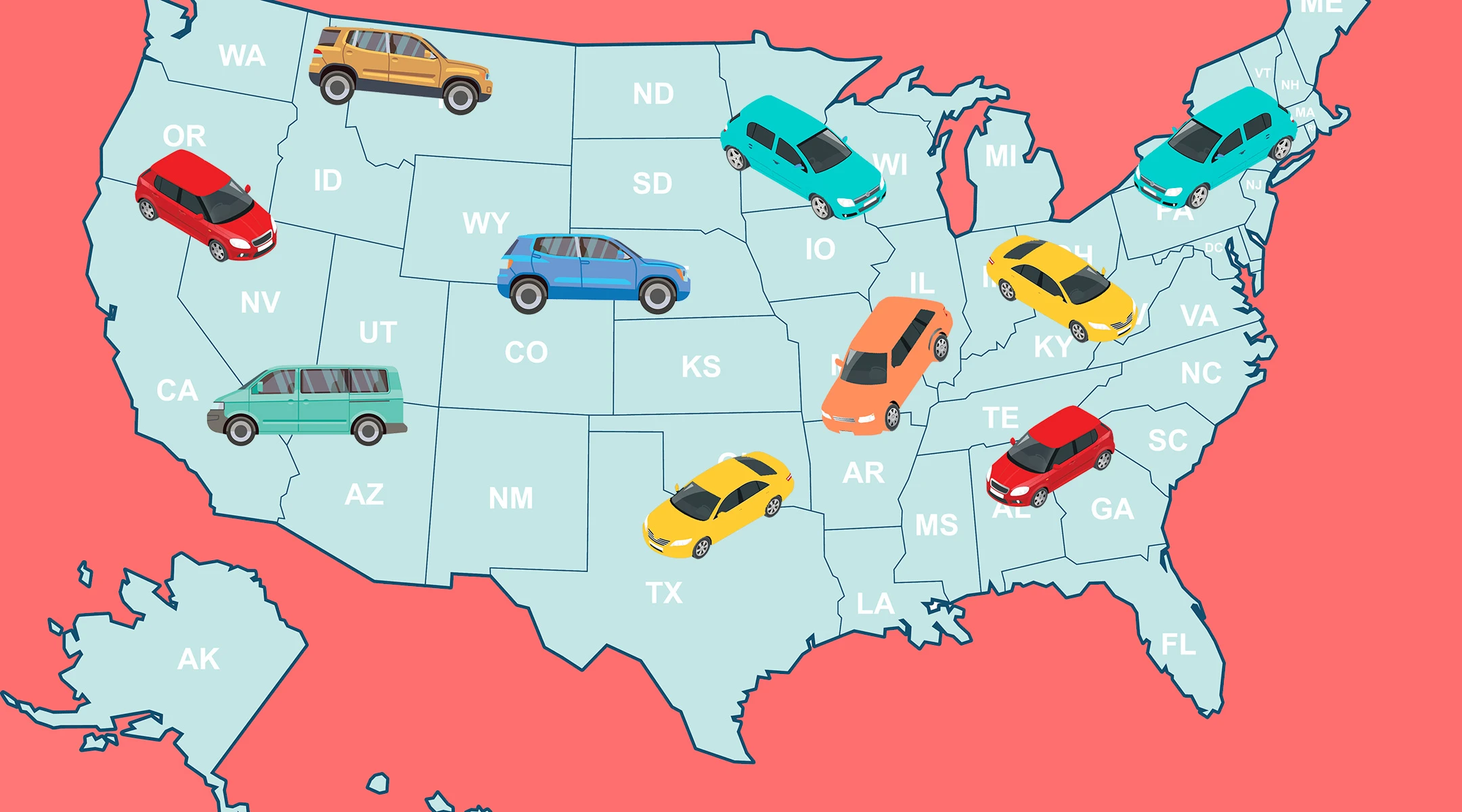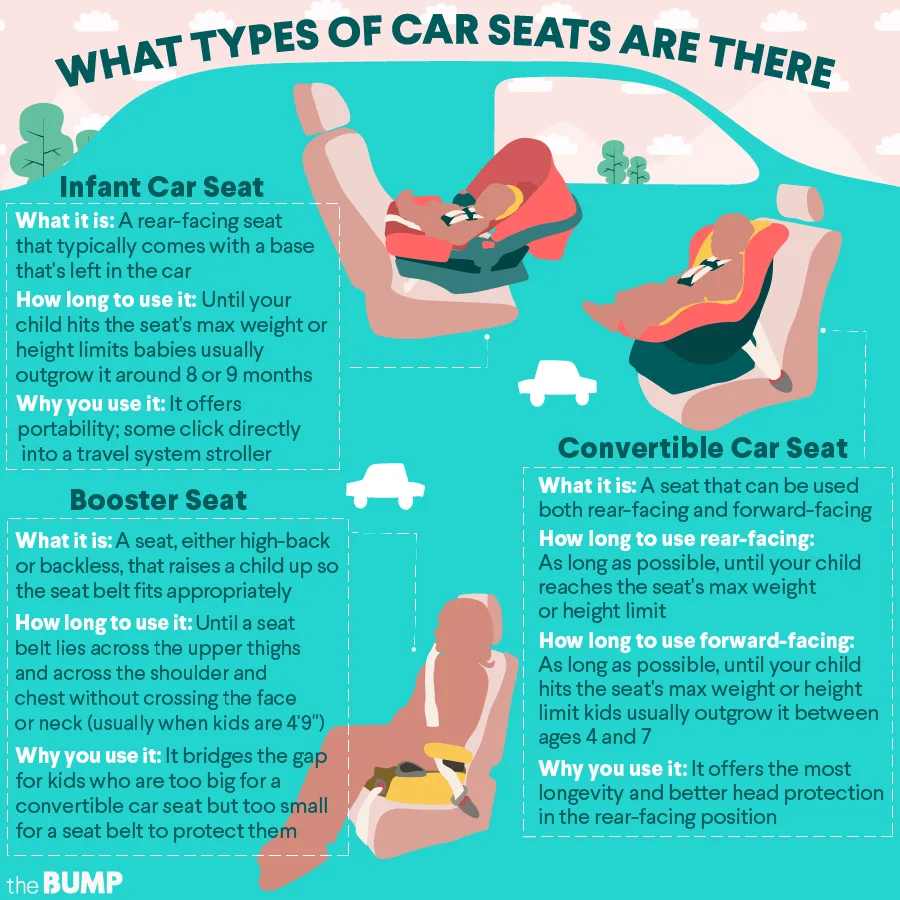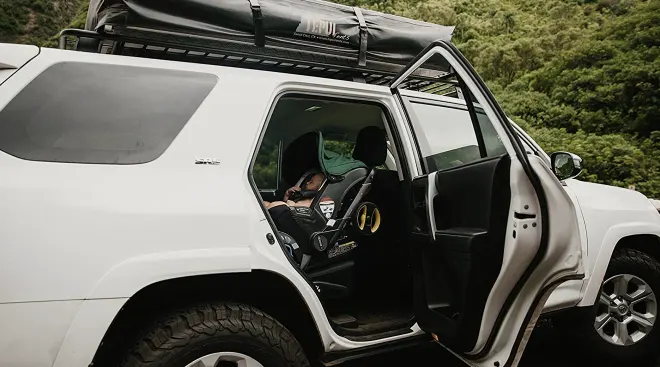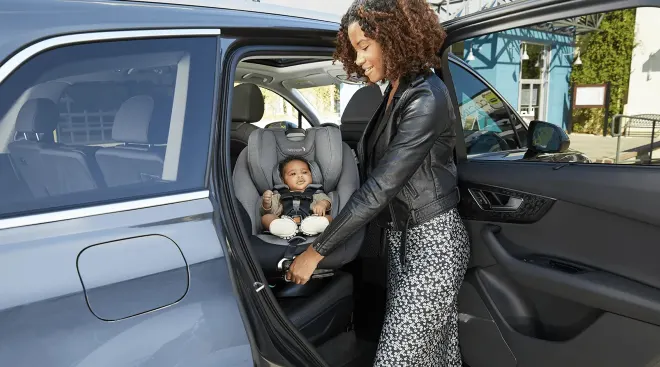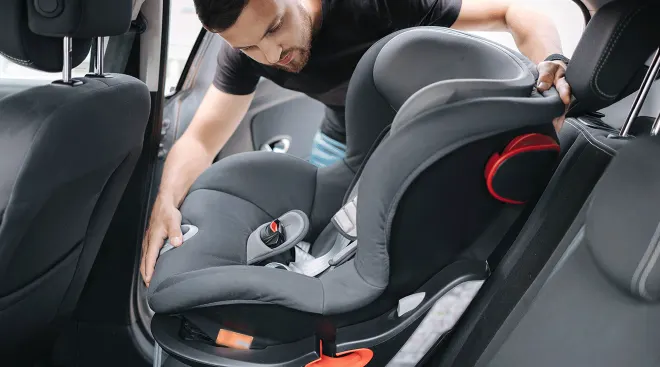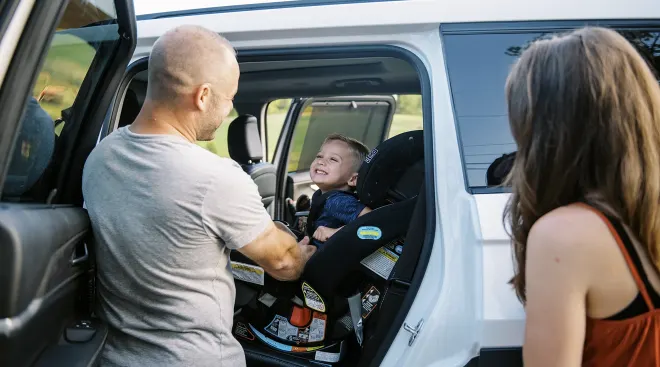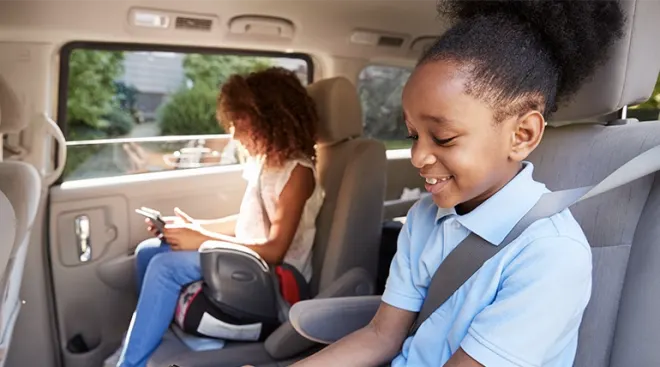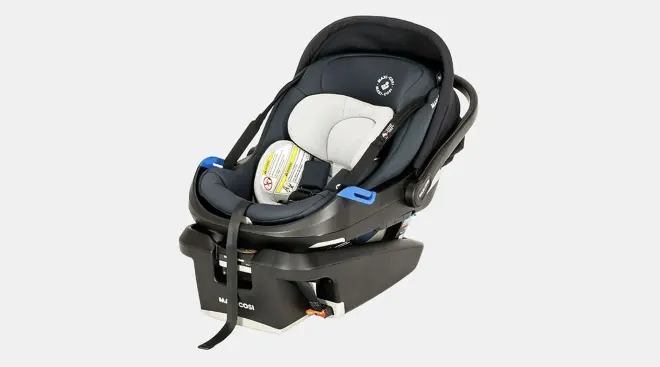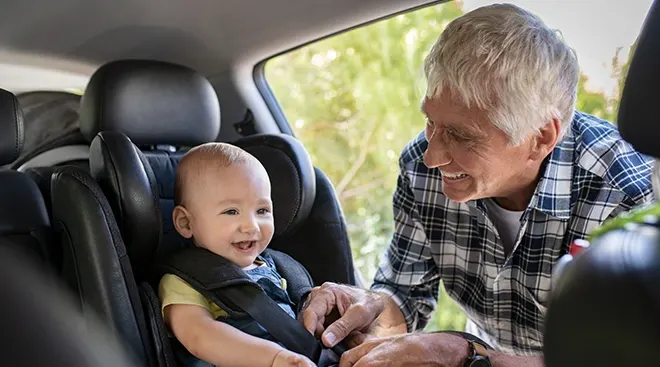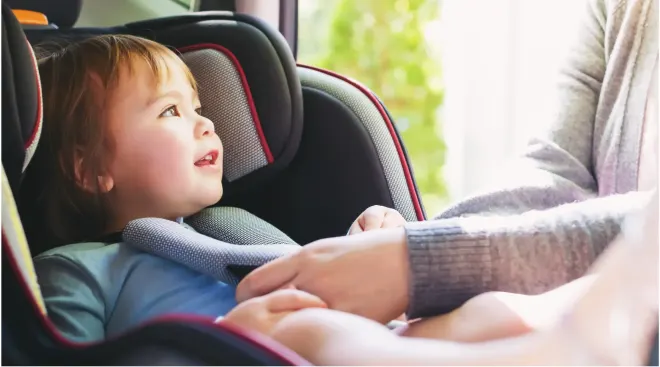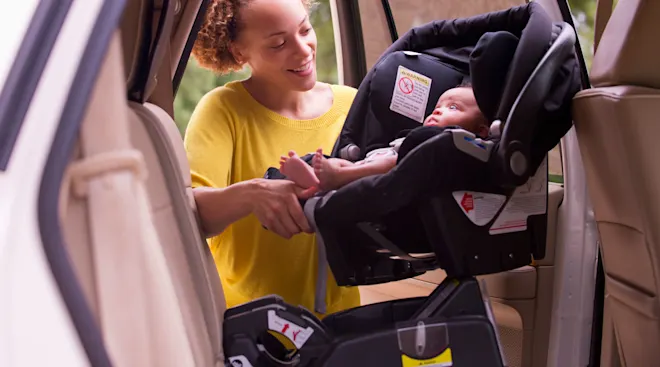A State by State Look at Car Seat and Booster Seat Laws
Every state—including Washington, DC—has car seat and booster seat laws that establish what kind of child restraint your kids should ride in, depending on their height, weight and age. But the specifics of those laws vary wildly from state to state.
They also tend to be pretty lax, especially when compared with the car seat and booster seat safety recommendations of the American Academy of Pediatrics (AAP). Those guidelines say children should remain in a rear-facing car seat until at least the age of 2, or whenever they outgrow the car seat’s height and weight limits. Toddlers and preschoolers should then use a forward-facing car seat until they again surpass the seat’s limits. Your kids should subsequently ride in booster seats until your car’s seat belts properly fit them—which usually happens when they’re 4 feet 9 inches tall or about 8 to 12 years old.
Because AAP safety recommendations are stricter than many state car seat and booster seat laws, if you follow AAP best practices, you’ll always be in compliance with the law. (Plus, you’ll be erring on the side of safety.) Read on to learn what the car seat and booster seat laws stipulate in each state across the US.
What’s legal in one state may not be legal in another once you cross state borders. In South Dakota, for example, children don’t have to sit in any kind of safety seat once they turn 4, while in Wyoming and Tennessee, kids require a safety restraint (whether it’s a car seat or booster seat) up to the age of 8. Here are some facts about car seat and booster seat laws to give you an idea as to how much they vary across the country:
• 48 states, DC and Puerto Rico require booster seats for children who have outgrown their car seats but are still too small for adult seat belts.
• 8 states (California, Connecticut, New Jersey, Oklahoma, Oregon, Pennsylvania, Rhode Island and South Carolina) require children younger than 2 to be in a rear-facing car seat.
• 5 states (California, Florida, Louisiana, New Jersey and New York) have seat belt requirements for school buses. Texas requires seat belts only on buses purchased after 2010.
• 2 states don’t have booster seat laws (Florida, South Dakota).
What happens when you violate those car seat laws also differs dramatically from state to state. Most child seat safety laws are considered “primary,” meaning police officers can stop you if they spot a violation of those car seat laws. But the same doesn’t hold true across the country: Nebraska and Ohio have secondary enforcement laws (depending on the child’s age and what kind of restraint they’re supposed to be riding in), meaning police have to have another reason to pull you over. If you are stopped and ticketed, your maximum fine for a car seat law infraction could be anywhere from $10 if you’re in Michigan to $500 if you’re driving in Nevada.
From when kids have to ride in a rear-facing car seat to when they can use an adult seat belt, here’s what car seat and booster seat laws look like in each state. As you’ll see, the state laws can sometimes seem a little vague: Some states refer to the use of a “car restraint” but don’t define what that is exactly; others don’t have specific requirements for when children can use an adult safety belt. In these cases, we suggest referring back to AAP guidelines.
Alabama car seat laws and booster seat laws
Children younger than 1 or less than 20 pounds must be in a rear-facing car seat. Once they’re between the ages of 1 and 4, or between 20 and 40 pounds, they can be in a front-facing car seat. Anyone older than 5 but younger than 6 needs to be in a booster seat.
Alaska car seat laws and booster seat laws
Kids younger than 1 or less than 20 pounds must be in a rear-facing car seat. If they’re between ages 1 and 3 and weigh more than 20 pounds, children still have to be in a child restraint. Kids ages 4 through 15 who are either shorter than 57 inches or weigh more than 20 pounds but less than 65 pounds have to use a booster seat. Once they hit 57 inches or 65+ pounds, they can graduate to an adult seat belt.
Arizona car seat laws and booster seat laws
All children under 4 must be in a child restraint, including kids up to 7 if they’re under 57 inches tall. Children 5 to 7 years old who are taller than 57 inches are allowed to use an adult seat belt.
Arkansas car seat laws and booster seat laws
If they’re 5 years old or younger and less than 60 pounds, children must be in a child restraint. Kids 6 and up or those heavier than 60 pounds can use just an adult seat belt.
California car seat laws and booster seat laws
All children under 2, less than 40 pounds and 40 inches must be in a rear-facing infant seat. Kids 7 year and younger or under 57 inches must ride in a booster seat. Once they’re at least 8 or at least 57 inches tall, adult seat belts can suffice.
Colorado car seat laws and booster seat laws
Children under a year and less than 20 pounds must be in a rear-facing car seat. Kids ages 1 to 3 and between 20 and 40 pounds still have to use a car seat. Four- to 7-year-olds must use a booster seat. When they turn 8, they can use an adult seat belt.
Connecticut car seat laws and booster seat laws
Kids under 2 and under 30 pounds must be in a rear-facing seat, and 2- to 4-year-olds between 30 and 40 pounds can be in a forward- or rear-facing seat. If they’re 5 to 7 and between 40 and 60 pounds, they can be in a car seat or a booster seat secured with a lap and shoulder belt. An adult seat belt can be used for children who are at least 8 and over 60 pounds.
Delaware car seat laws and booster seat laws
All children under 7 and less than 66 pounds must be in a child restraint. Adult seat belts are fine for kids 8 and up or those weighing more than 66 pounds.
District of Columbia car seat laws and booster seat laws
Kids 7 years and younger must be in a child restraint; those who are 8 and up can use an adult seat belt.
Florida car seat laws and booster seat laws
Children 5 years and younger must be in a child restraint.
Georgia car seat laws and booster seat laws
All children 7 years or younger or 57 inches or shorter must be in a child restraint—once they exceed 57 inches, they can use just an adult seat belt.
Hawaii car seat laws and booster seat laws
Kids 3 and younger must use a car seat, and those between the ages of 4 and 7 have to use a booster seat. An adult seat belt can be used if the child is 4 to 7 years old and taller than 4 feet 9 inches.
Idaho car seat laws and booster seat laws
All children 6 years or younger must be in a child restraint.
Illinois car seat laws and booster seat laws
Everyone 7 years or younger must use a child restraint. For kids 8 and up, adult seat belts are fine—they can use a lap-only belt as long as they’re over 40 pounds and in the back seat.
Indiana car seat laws and booster seat laws
Kids 7 years or younger must use a child restraint. Adult seat belts can be used when they’re at least 8.
Iowa car seat laws and booster seat laws
If the child is younger than 1 or less than 20 pounds, he’s got to be in a car seat. Between 1 and 5, kids have to be in a child restraint or booster seat. An adult seat belt is okay for kids 6 and up.
Kansas car seat laws and booster seat laws
Children under 3 must be in a car seat. Kids also need to be in a car seat or booster seat if they’re between 4 and 7 and less than 80 pounds or less than 57 inches tall. An adult seat belt can be used for children who are least 8; it’s also permitted if kids 4 through 7 weight more than 80 pounds or are taller than 57 inches.
Kentucky car seat laws and booster seat laws
Kids under 40 inches must be in a car seat. Children 7 or younger who are between 40 and 57 inches must use a booster seat. Once they pass 57 inches they can use an adult seat belt.
Louisiana car seat laws and booster seat laws
Children younger than 1 and less than 20 pounds must be in a rear-facing car seat. Those between the ages of 1 and 3 and between 20 and 39 pounds can use a forward-facing car seat. Kids between 4 and 5 and between 40 and 60 pounds must be in a booster seat. Adult seat belts are allowed for kids 6 years old or those who weight more than 60 pounds.
The Bump’s Car Seat Types infographic:
Maine car seat laws and booster seat laws
All children under 40 pounds must use a car seat. Kids between 40 and 80 pounds and less than 8 years old must be in a child restraint or booster seat. When they’re 8 or taller than 4 feet 9 inches, adult seat belts are allowed.
Maryland car seat laws and booster seat laws
Kids 7 and younger or under 57 inches must be seated in a child restraint. Adult seat belts are permitted for those who are 8 years old or at least 57 inches tall.
Massachusetts car seat laws and booster seat laws
All children 7 and younger or under 57 inches must be seated in a child restraint. Kids who are 8 or at least 57 tall can use an adult seat belt.
Michigan car seat laws and booster seat laws
Those who are 7 and younger or under 57 inches must be seated in a child restraint. Kids who are 8 or at least 57 inches tall are allowed to use an adult seat belt.
Minnesota car seat laws and booster seat laws
All children 7 and younger or under 57 inches must be seated in a child restraint.
Mississippi car seat laws and booster seat laws
Kids under the age of 3 must be in a car seat. Children between ages 4 and 6 and either less than 57 inches or less than 65 pounds have to be in a booster seat. An adult seat belt is allowed for those who are 6 and younger who either weigh at least 65 pounds or are at least 57 inches tall.
Missouri car seat laws and booster seat laws
All children under the age of 3 and less than 40 pounds must use a car seat. Children between 4 and 7 who are at least 40 pounds but less than 80, and who are either 4 feet 9 inches or shorter must be in a booster seat. For those who are 8 and up, or who weigh at least 80 pounds or are taller than 4 feet 9 inches, adult seat belts are okay to use.
Montana car seat laws and booster seat laws
Children 5 years and younger and under 60 pounds must use a child restraint.
Nebraska car seat laws and booster seat laws
Kids 5 years and younger must be in a car seat. When they reach 6, they can use an adult seat belt.
Nevada car seat laws and booster seat laws
Those who are 5 years and younger or 60 pounds or less must be in a car seat.
New Hampshire car seat laws and booster seat laws
All children who are 6 years and younger and less than 57 inches must be in a car seat. Kids who are least 7 years old, or who are at least 57 inches tall, are allowed to use an adult seat belt.
New Jersey car seat laws and booster seat laws
All kids under 2 and less than 60 pounds must be in a rear-facing infant seat. Children younger than 4 and less than 40 pounds should also be in a rear- or forward-facing car seat until she outgrows the seat’s limits. Anyone younger than 8 years old or less than 57 inches should also be in a forward-facing seat until they outgrow the seat.
New Mexico car seat laws and booster seat laws
All children under the age of 1 should be in a rear-facing child restraint. Kids 1 through 4, or less than 40 pounds, should be in a child restraint. When they’re 5 through 6, or less than 60 pounds, they need to be in a booster seat. They can graduate to an adult seat belt when they’re 7.
New York car seat laws and booster seat laws
Kids 7 and under must be in a child restraint. Adult seat belts are permitted for kids 8 and up or those weighing more than 40 pounds.
North Carolina car seat laws and booster seat laws
Children 7 years and younger or less than 80 pounds have to be in a child restraint. Once a child is 8 years old or weighs between 40 and 80 pounds, he can use an adult lap belt.
North Dakota car seat laws and booster seat laws
Child restraints are required for kids 7 years and younger or less than 57 inches tall. For 8-year-olds or 7-year-olds (and younger) who are at least 57 inches tall, adult seat belts are acceptable.
Ohio car seat laws and booster seat laws
Kids 3 years and younger or less than 40 pounds must be in a child restraint, while children 4 to 7 who are at least 40 pounds but under 57 inches tall must sit in a booster seat. When they turn 8, kids can use adult seat belts.
Oklahoma car seat laws and booster seat laws
Kids younger than 2 need to be in a rear-facing car seat until she outgrows the seat’s limits. All children under 4 should be in a child restraint, and kids 4 to 7 should ride in a booster seat, as long as they’re shorter than 4 feet 9 inches. Those who are 8 years old or taller than 4 feet 9 inches can use an adult seat belt.
Oregon car seat laws and booster seat laws
Children under 2 must be in a rear-facing child restraint. All children 7 and under or 40 pounds or less must also be in a child restraint; kids more than 40 pounds but under 4 feet 9 inches should be in a booster seat. An adult seat belt can be used for kids taller than 4 feet 9 inches or at least 8 years old.
Pennsylvania car seat laws and booster seat laws
Kids younger than 2 need to be in a rear-facing car seat until he outgrows the seat’s limits. Children 2 to 3 must be in a forward-facing car seat, and children 4 to 7 must use a booster seat. Once they hit 8, kids can use an adult seat belt.
Rhode Island car seat laws and booster seat laws
A rear-facing car seat is required for children younger than 2 or less than 30 pounds. Children 7 and younger, less than 57 inches or less than 80 pounds have to still be in some sort of child restraint. Adult seat belts can be used for kids 8 and up or those who are 7 and under who weigh more than 80 pounds or are at least 57 inches tall.
South Carolina car seat laws and booster seat laws
All children under 2 must be in a rear-facing child restraint until they exceed the manufacturer’s limits. Children under 2 who outgrow the limits and children over 2 must be in a forward-facing car seat until they surpass that seat’s limits. A booster seat then has to be used for kids over 4 who are too big for a car seat, until they’re at least 8 years old or 57 inches tall.
South Dakota car seat laws and booster seat laws
Kids under 4 or less than 40 pounds must be in a child restraint. Adult seat belts are allowed for kids who are at least 5 years old or who weigh at least 40 pounds.
Tennessee car seat laws and booster seat laws
A rear-facing car seat must be used for children under 1 or less than 20 pounds. Kids between the ages of 1 and 3 and more than 20 pounds can transition into a forward-facing car seat. Children 4 to 8 but under 4 feet 9 inches should ride in a booster seat until they’re 9 years old or at least 4 feet 9 inches.
Texas car seat laws and booster seat laws
Children 7 years and younger and less than 57 inches tall must ride in a child restraint.
Utah car seat laws and booster seat laws
A child restraint has to be used for children 7 years and younger and less than 57 inches tall.
Vermont car seat laws and booster seat laws
Children under 1 and less than 20 pounds must be in a rear-facing car seat. Children 1 to 7 who weigh more than 20 pounds must be in a child restraint or booster seat. Once they’re at least 8 years old and more than 20 pounds, they can use an adult seat belt.
Virginia car seat laws and booster seat laws
A child restraint must be used for kids 7 and younger. Adult seat belts are allowed once kids are 8.
Washington car seat laws and booster seat laws
All children 7 and younger and under 4 feet 9 inches must be in a child restraint. You can use an adult lap belt for kids who are either age 8, or age 7 or younger but at least 4 feet 9 inches tall, or are more than 40 pounds.
West Virginia car seat laws and booster seat laws
Kids 7 and younger and under 4 feet 9 inches must be in a child restraint. Once they’re at least 4 feet 9 inches, they can use an adult seat belt.
Wisconsin car seat laws and booster seat laws
All children under the age of 1 and under 20 pounds must ride in a rear-facing child restraint. Kids 1 to 3 who weigh more than 20 pounds but less than 40 pounds must also be in a child restraint (rear-facing or forward-facing). Meanwhile, children 4 to 7 who are between 40 and 80 pounds and are less than 57 inches tall must ride in either a forward-facing car seat or a booster seat. An adult seat belt is acceptable for kids 8 or those who are younger than 8 but weigh more than 80 pounds and are 57 inches or taller.
Wyoming car seat laws and booster seat laws
Children 8 and younger must ride in a child restraint.
Published September 2017
Please note: The Bump and the materials and information it contains are not intended to, and do not constitute, medical or other health advice or diagnosis and should not be used as such. You should always consult with a qualified physician or health professional about your specific circumstances.
Navigate forward to interact with the calendar and select a date. Press the question mark key to get the keyboard shortcuts for changing dates.
































